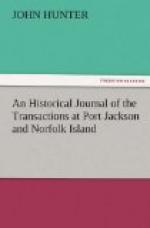We now had two formidable enemies to encounter in the rat and grub-worm, both which were very numerous and destructive: some wheat had been sown in the garden ground on the 11th, and the next morning there was not a grain of it left, being all eat up by the rats; and the few potatoes and other vegetables, which escaped the bad effects of the southerly wind, were all eat up by the grub-worm. I have before observed, that on our first discovering the rats to be numerous, I ordered the empty casks to be converted into traps, and for some time they were very successful, thirty or forty rats being caught for several nights together: these were killed, and scattered about the garden, to deter the rest from coming to the place; but they soon grew too cunning to be caught in the traps, and too bold to be intimidated by their dead companions. I next caused some glass to be pounded very fine, and mixed with oatmeal, which being distributed about the garden, killed vast numbers of them.
To prevent the bad effects of the grub-worm, I tried ashes, lye of ashes, and urine, but to no purpose, so that the women were kept constantly employed in picking them off the few plants we had left.
Out of six ewes which I brought to the island, five died with the scab, notwithstanding every possible care was taken of them; and one of my sows was poisoned, by eating something noxious in the woods. The remainder of my small stock was likely to do very well: it consisted of two ewes, three sows, two boars, four hens, one cock, three ducks, one drake, and one goat.
The sugar-cane, two Rio Janeiro banana trees, and two orange trees, which I brought with me, were kept in tubs, until I should find a sheltered situation to plant them in. The wind seemed now to be set in from the southward, and the weather was very raw and cold, so that I called this the beginning of winter. Another of my sows was poisoned on the 24th, so that I found it necessary to confine them in a hog-pen, which, in regard to feeding them, was a great inconvenience, as they used to provide very well for themselves in the woods; fortunately, however, a tree was found which afforded them very good food: this tree grows to the height of eighty feet, and the branches, which resemble those of the palm-tree in their growth, fall off every year, leaving an indentation in the trunk. The leaves of these branches, which are twelve in number, are much like the heath-fern, from whence this tree obtained the name of the fern-tree. The middle of the tree, from the root to the apex, consists of a white substance resembling a yam, and when boiled, it tastes like a bad turnip; this the hogs fed on very eagerly: the outside of the trunk is hard wood, and full of regular indentations from the top to the bottom. The tree is found in great plenty in all parts of the island.
At the end of this month, I sent some of the people to assist Mr. Altree, at the plantation in Arthur’s Vale, which was the name I gave to the valley he had begun to clear; the rest were employed in clearing the ground at Mount George, except three men, whom I set to dig a cellar under my house.




